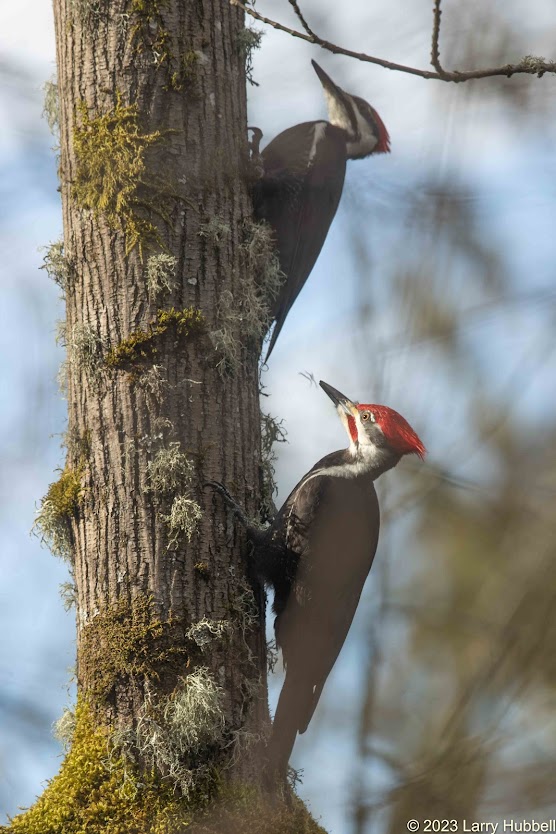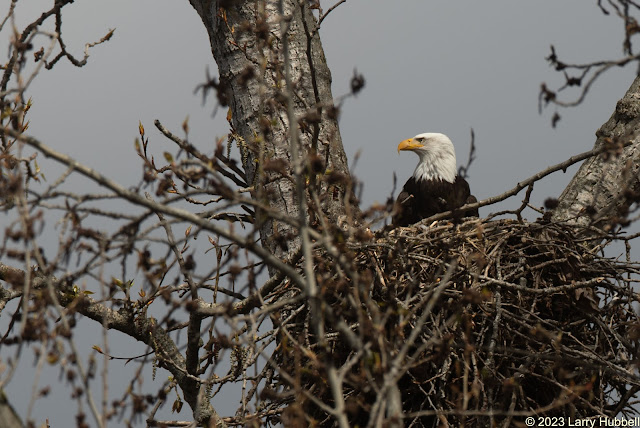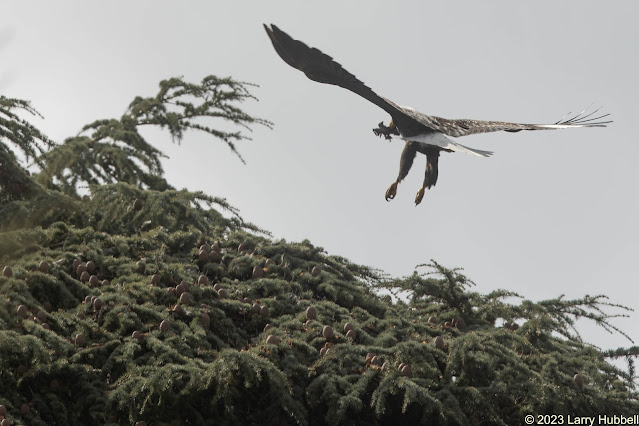The sky may be cloudy, the wind may be cold, and the rain may dampen our spirits, but please button your coat, step outside, and take a second look. Among the bare branches you will find buds in the trees and birds building nests. At eye level, you will see plants sporting fresh green leaves and some will have flowers in bloom. Spring is a gift and Winter is the box it comes in.
Last week, the Brown Creepers were gathering material for a new nest.
This week, a Red-breasted Nuthatch was excavating a potential nest site.
Yesterday, my friend, Sam found, not just one, but two active Anna's Hummingbird nests. Each egg is about the size of a vitamin. (Thank you, Sam, for this photo.)
This morning, April 1st, the Ravens, in the Arboretum, appeared to be feeding their young.
They are quite intelligent, but I don't think they are attempting an April Fool's prank. I first noticed them behaving like they were on eggs around March 6th. According to All About Birds, their incubation period is 20 to 25 days. So, it really is time. I suspect their young may be the first nestlings to hatch out in the Arboretum this year. Another sure sign of Spring.
March 9th was the last time I saw pairs of Barred Owls. Soon after, I suspect they began incubating eggs. Lately, I have seen only solitary owls. I wonder if they are the males standing guard near the nests, while the females are on eggs and discreetly hidden from view.
Cooper's Hawks have been selecting small branches for their nests.
The Pileated Woodpeckers are spending time together. Earlier in March, my friend, Sally, spotted the male excavating a hole in Red Alder snag. It was near the top and not very spacious so I am uncertain if he is really building a nest or perhaps just getting in shape for a more serious effort.
On Thursday morning, Monty and Marsha changed their behavior. For weeks, they have been around the nest tree, off and on. Sometimes, sitting on the edge of the nest, sometimes delivering sticks, and sometimes nowhere to be found. However, on Thursday, I noticed Marsha sitting low in the nest. Her positioning felt like the final declaration that Spring is underway.
When she got up and put her head down in the nest I could see her tail wiggling but it was not the jerking movement that happens when she is eating. It was much more subtle.
Finally, when she turned and pointed her wingtips and tail feathers toward the sky there was little doubt in my mind about what she was doing. I suspect her subtle movements happened as she gently turned her eggs and that while showing her wingtips she was using her wings to shield her eggs from the cold.
When an eagle, while standing in a nest, lowers their secondaries next to its legs they create a shield on each side of the legs. At the same time, their primaries point toward the sky while their body provides protection from above. As far as I know, the only time they do this is when they are protecting eggs or eaglets in the nest. Thank you, Martin, for teaching me what to look for!
A couple weeks ago, I saw one of the Broadmoor eagles, probably Eva, sitting low in her new nest. (You can read about her nest falling late last Summer by
Clicking Here.) I remember hearing that older birds often lay their eggs earlier than younger birds. I suspect Eva may be one of the oldest Eagles around Union Bay.
When we zoom into the photo we can just barely see her head poking up above the edge of the new nest. This made me think she began incubation on or before March 13th.
If we assume incubation takes about 5 weeks and then it takes another week or so for the young eaglets to become visible above the edge of the nest, then we can hope to see young in the Broadmoor nest on or before early May and in the Montlake Cut aerie about two weeks later.
Back at Montlake Cut, on Thursday afternoon one of the adults was really low in the nest.
Even eagles get impatient and feel the need to move around, so they occasionally become more or less visible, while incubating eggs.
When the eagle became seriously interested in something to the west, I got an even better look. I felt pretty sure it was Marsha, due to the slight gray smudge behind her eye. Later, Monty returned to the nest with food.
By that point, I was on the opposite side of the tree and the sun was in my eyes. I assumed an exchange was made and that Marsha was the one who took the food to a nearby treetop.
However, when I studied the photo, I found the eagle, who was eating, looked more like Monty than Marsha.
After eating, the eagle went back to the nest for a moment and then jumped out and flew a quick circuit over the east end of Montlake Cut. As it returned to the nest I caught this photo. Once again this eagle still looked like Monty. He is cleanly white behind the eyes.
Sometimes, they take turns incubating the eggs and it can be challenging to tell which one is which.
While this was taking place the mate, Marsha I presume, was circling above the UW Medical Center. Surprisingly, Monty decided to join her. The two of them circled together for a few minutes.

Before long, one of them returned to the nest. As my friend, Amy, pointed out maybe they just needed some time together away from the eggs. Although, I also wondered if they had a heart-to-heart discussion about whose turn it was to have nest duty.
In any case, while incubating eggs, I would expect that one or the other will be there almost constantly for the next six weeks. Although, as the cottonwoods leaf out it will become progressively more difficult to actually see them in the nest.
The good news is, both Monty and Marsha are present, accounted for, and moving forward with the parenting process. Congratulations to Monty and Marsha. I certainly hope they have all the young they desire, that their nest is stable and stays in the tree and that their young successfully fly whenever they attempt to leave the nest.
Have a great day on Union Bay...where nature lives in the city and Black Birders are welcome!
Larry
ps: Can you find Monty and Marsha's nest in the very first photo in this post? If not, read just the Going Native answer.
Each of us, who breathes the air, drinks water, and eats food should be helping to protect our environment. Local efforts are most effective and sustainable. Native plants and trees encourage the largest diversity of lifeforms because of their long intertwined history with our local environment and native creatures. Even the microbes in the soil are native to each local landscape.
I hope we can inspire ourselves, our neighbors, and local businesses to respect native flora and support native wildlife at every opportunity. I have learned that our most logical approach to native trees and plants (in order of priority) should be to:
1) Learn and leave established native flora undisturbed.
2) Remove invasive species and then wait to see if native plants begin to grow without assistance. (When native plants start on their own, then these plants or trees are likely the most appropriate flora for the habitat.)
3) Scatter seeds from nearby native plants in a similar habitat.
4) If you feel you must add a new plant then select a native plant while considering how the plant fits with the specific habitat and understanding the plant's logical place in the normal succession of native plants.
***************
My friend Elaine Chuang shared several resources (that were new to me) from the January 2022 Washington Ornithological Society meeting. By the way, Elaine credits Vicki King for researching and supplying this information. Keystone native plants are an important new idea. Douglas Tallamy in the book "Nature's Best Hope " explains that caterpillars supply more energy to birds than any other plant eater. He also mentions that 14% of our native plants, i.e. Keystone Plants, provide food for 90% of our caterpillars. This unique subset of native plants and trees enables critical moths, butterflies, and caterpillars that in turn provide food for the great majority of birds, especially during the breeding season.
Here are the top two relevant links.
A video all about native keystone plants for wildlife:
https://www.youtube.com/watch?v=O5cXccWx030
New! Updated resources for adding keystone native plants to your yard.
https://wos.org/wos-wp/wp-content/uploads/2022/10/Native-Plant-Resources-10-7-22.pdf
This updated collection includes a variety of new and different books, perspectives, and interactions between plants, birds, and insects. Thank you to Vicki King for continuing to collect all of these exceptionally helpful works. Also, thank you to each of the individuals who contributed.
***************
In the area below it is my intention to display at least one photo each week to help challenge us to know the difference between native and non-native lifeforms.
The following four native plants, which are all close to or in bloom, are clearly heralding the arrival of Spring. Do you know their names? Which of these four might be considered odorous?
A)
B)
C)
D)
Scroll down for the answer.
******************
A) Flowering-red Currant
B) Osoberry
C) Oregon Grape
D) Skunk Cabbage
The name Skunk Cabbage is a complete giveaway. Yes, it is odorous.
In my opinion, the Red Flowering Currant also has an odor that is not perfectly pleasant. However, I suspect we do not all perceive odors the same. I suggest you find and visit an established and well-flowered bush before choosing to plant it in your yard.
(Monty and Marsha's nest is on the far left side of the first photo. It is about 75 percent of the way up the left most cottonwood.)
*****************
The Email Challenge:
Over the years, I have had many readers tell me that Google is no longer sending them email announcements. As of 2021, Google has discontinued the service.
In response, I have set up my own email list. With each post, I will manually send out an announcement. If you would like to be added to my personal email list please send me an email requesting to be added. Something like:
Larry, Please add me to your personal email list.
My email address is:
LDHubbell@comcast.net
Thank you!
*******************
The Comment Challenge:
Another common issue is losing your input while attempting to leave a comment on this blog. Often everything functions fine, however, sometimes people are unable to make it past the robot-detection challenge or maybe it is the lack of a Google account. I am uncertain about the precise issue. Sadly, a person can lose their comment with no recovery recourse.
Bottom Line: If you write a long comment, please, copy it before hitting enter. Then, if the comment function fails to record your information, you can send the comment directly to me using email.My email address is:
LDHubbell@comcast.net
Sincerely,Larry


























Thanks for assuring us that Spring is here and providing evidence.
ReplyDeleteYou are welcome! I hope you are getting out and enjoying it!
Delete